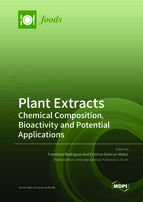Investigation of Phenolic Composition and Anticancer Properties of Ethanolic Extracts of Japanese Quince Leaves
Round 1
Reviewer 1 Report
I have no comments
Author Response
We thank the Reviewer for the positive evaluation of our manuscript.
Reviewer 2 Report
The revision was well done, and no more comments.
Author Response
We thank the Reviewer for the evaluation of our manuscript. We have revised Introduction, Methods and Conclusions to make them clearer and more informative.
Reviewer 3 Report
I carefully read the revised version of the manuscript entitled: Investigation of phenolic composition and anticancer properties of ethanolic extracts of Japanese quince leaves. I believe the manuscript has improved significantly; however, I have some comments on the revised version.
Major comments:
- What is the effect of temozolomide on the primary rat cells? It would be of interest as the extracts you use, have high levels of cytotoxicity in these cells
- Why do you mention in the last sentence of the conclusion that these extracts would be useful for the food industry? Where do you support this statement?
- The fact that ethanol seems to be cytotoxic alone, is a bit concerning. Is there any other way to dilute the extracts? How relevant is this to a more translational scenario?
Minor comments:
- Line 112. Please change the number 24 in the beginning of a sentence wit letters
- Line 154. Please make 50 in the EC50 a subscript
- Line 184. This paragraph does not contain information only on the extracts but on the major compoments as well. Please rephrase.
Author Response
Response:We thank the Reeviewer for the efforts in revising our manuscript and for all the valuable comments and suggestions
Major comments:
1. What is the effect of temozolomide on the primary rat cells? It would be of interest as the extracts you use, have high levels of cytotoxicity in these cells
Response: We agree that evaluation of temozolomide cytotoxicity on primary brain cells would provide a relevant additional information for this study. However, preparation of primary cerebellar cell culture needs much more time until ready for experiments compared to cell lines (see Methods) and the procedures would hardly be manageable in the time period provided for revision. We have not found similar temozolomide cytotoxicity comparison between rodent glioblastoma and primary brain cells. However, there is a recent study comparing the effect of temozolomide and doxorubicin on human 3D heterotypic glioblastoma brain spheres consisting of glioblastoma tumor cells, iPSC-derived neurons, glial cells and astrocytes grown in a spheroid and iPSC-derived neurons [1]. The study reports that 100 microM of temozolomide and 0.3 microM of doxorubicin efficiently decreases heterotypic glioblastoma spheroids by inducing apoptosis without altering the number of normal neuronal cells in the model. Thus, human primary brain cells are likely more resistant to both temozolomide and doxodubicin compared to glioblastoma cells.
2. Why do you mention in the last sentence of the conclusion that these extracts would be useful for the food industry? Where do you support this statement?
Response: We agree that the main findings of the study are not related to functional food design and the statement is not appropriate. We have removed the sentences about functional food from the Discussion and Conclusions.
3. The fact that ethanol seems to be cytotoxic alone, is a bit concerning. Is there any other way to dilute the extracts? How relevant is this to a more translational scenario?
Response: Phenolic compounds are usually soluble in organic solevents, such as ethanol or DMSO. DMSO is also usually applied to dissolve temozolomide. Such solvents posess certain degree of cytotoxicity and thus, the applicability of such preparation is limited. Application of co-solvents, such as polyethylene glycol, might improve solubility of phenolic compounds and increase bioactivity of hydrophilic preparations [2,3]. Thus, application of such co-solvents for quince leaf extract preparation could be one of the available options. The main compound and, most likely, the key mediator of the anticancer properties of quince leaf extracts chlorogenic acid has some degree of solubility in water, which can be increased by dissolving at higher temperatures and, possibly by application of co-solvents.
Minor comments:
1. Line 112. Please change the number 24 in the beginning of a sentence with letters
Response: Changed as suggested.
2. Line 154. Please make 50 in the EC50 a subscript
Response: Changed as suggested.
3. Line 184. This paragraph does not contain information only on the extracts but on the major compoments as well. Please rephrase.
Response: We have revised the sentence in line 184 to: „The main phenolic glycosides found in the extracts were isoquercitrin, hyperoside, and quercitrin.
Literature:
- Plummer, S.; Wallace, S.; Ball, G.; Lloyd, R.; Schiapparelli, P.; Quiñones-Hinojosa, A.; Hartung, T.; Pamies, D. A Human iPSC-derived 3D platform using primary brain cancer cells to study drug development and personalized medicine. Sci. Rep. 2019, 9, 1–11, doi:10.1038/s41598-018-38130-0.
- Kubiliene, L.; Jekabsone, A.; Zilius, M.; Trumbeckaite, S.; Simanaviciute, D.; Gerbutaviciene, R.; Majiene, D. Comparison of aqueous, polyethylene glycol-aqueous and ethanolic propolis extracts: Antioxidant and mitochondria modulating properties. BMC Complement. Altern. Med. 2018, 18, 165, doi:10.1186/s12906-018-2234-5.
- Seker, A.; Arslan, B.; Chen, S. Recovery of Polyphenols from Grape Pomace Using Polyethylene Glycol (PEG)-Grafted Silica Particles and PEG-Assisted Cosolvent Elution. Molecules 2019, 24, 2199, doi:10.3390/molecules24122199.
Round 2
Reviewer 3 Report
Dear Authors,
I read the revised version of your manuscript and it seems to be improved. All my comments were sufficiently answered, so I believe the manuscript is suitable.




